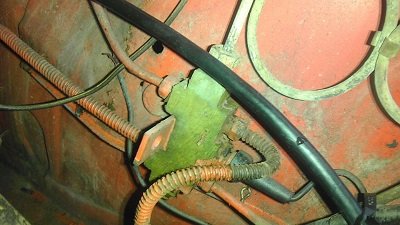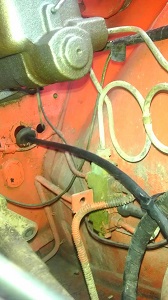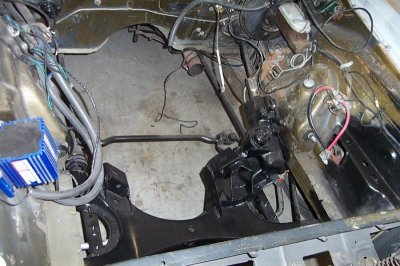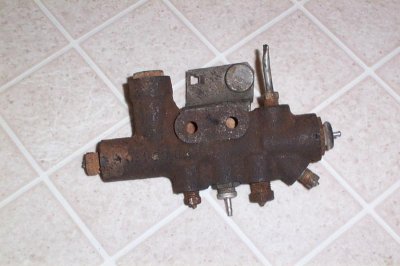cbunt1
Well-Known Member
First the known:
'72 Satty, originally equipped with different brakes than it has now, assume 4w drums, manual brakes. Currently has front disc, with a proper manual disc MC. It has 10" rear, but don't know if that's really an indicator of original discs or not.
The current disc brakes are not original to a '72 Satty though...they're mounted to the rear of the hub rather than the front as would be factory on a '72, at least as I understand. Car was assembled in 2/72, so it's not a late-year '72 model.
I replaced the MC with a NEW (not rebuilt) MC, new rear shoes, drums, cylinders, rebuilt calipers, front hoses, and had to replace a banjo bolt in the process. I know I should duplicate swaps and changes side-to-side, but couldn't find but one aftermarket banjo bolt locally (have a set on order). I ended up going with the Dorman.
After bleeding the system out (bleeders on the top-side, which means the calipers are swapped right-to-left from "proper" part numbers) I went for a test drive.
I'm getting what is effectively a sticking caliper on one side of the car, (I really think they're both sticking, but one's just sticking harder than the other). After a drive around the block with a couple of hard braking tests, I pulled it in the driveway and jacked it up, and sure-enough, a wheel so tight I couldn't turn it.
I cracked the bleeder screw, and it squirted fluid as though someone was on the pedal -- and released the brake...so I feel pretty sure that I'm getting a hydraulic lock rather than a mechanical lock.
So...here's where I start dabbling in the unknown:
As I say, the calipers are mounted to the rear-side of the axle, which to my understanding is NOT OE for a '72 model. Additionally, every part number I'm able to look up shows a '72 using a straight-input brake hose rather than a banjo hose.
The calipers I bought match the calipers that were on the car, and I specced them from a '72 satellite -- they're a perfect match, except that the installation ends up being a left-to-right cross due to the location of the bleeders and hoses. I've verified that I don't have any hard kinks in the hose -- at least not that I can see.
My thinking is that the PO to the PO did a "junkyard upgrade" with '73-'76 parts. I haven't pulled the knuckle casting numbers, but given that the calipers mount to the rear, I'd bet that they swapped with the newer car both from an availability aspect and for the cheaper rotors and newer bearing configuration - I haven't pulled the hubs off the car yet to see. I'm basing this on the simple fact that the correct brake hoses I was able to find list for the 73-76 models. BUT....the calipers are '72 calipers.
So my first question is this: Has anyone had problems with banjo brake fittings not releasing pressure? I'm thinking of taking the new set and turning the neck (un-threaded) down a couple of thou to see if I can get more fluid clearance and possibly a release of the fluid.
Next question is: If the calipers on the car were designed for a straight-fitting, would that typically create a problem with fluid release?
Or is it likely that my problem is further upstream? In typing this, it occurs to me that drum brakes typically require residual pressure, where discs can't take it (given no return springs in a caliper configuration) -- were the valves on the '72 models setup to provide this pressure, or is this residual handled in the wheel cylinders like on the GM cars I've messed with in the past?
Any thoughts? It's got me a little baffled, especially since I think I'm working with a hodge-podge of parts...'72 calipers, '73-76 brackets, and maybe spindles, and unknown origin for the car itself.
I don't mind going back to the parts-house and getting '73 calipers to go with the rest of the setup, but I'd hate to do that and it turn out to be an issue with the banjo bolts themselves...
'72 Satty, originally equipped with different brakes than it has now, assume 4w drums, manual brakes. Currently has front disc, with a proper manual disc MC. It has 10" rear, but don't know if that's really an indicator of original discs or not.
The current disc brakes are not original to a '72 Satty though...they're mounted to the rear of the hub rather than the front as would be factory on a '72, at least as I understand. Car was assembled in 2/72, so it's not a late-year '72 model.
I replaced the MC with a NEW (not rebuilt) MC, new rear shoes, drums, cylinders, rebuilt calipers, front hoses, and had to replace a banjo bolt in the process. I know I should duplicate swaps and changes side-to-side, but couldn't find but one aftermarket banjo bolt locally (have a set on order). I ended up going with the Dorman.
After bleeding the system out (bleeders on the top-side, which means the calipers are swapped right-to-left from "proper" part numbers) I went for a test drive.
I'm getting what is effectively a sticking caliper on one side of the car, (I really think they're both sticking, but one's just sticking harder than the other). After a drive around the block with a couple of hard braking tests, I pulled it in the driveway and jacked it up, and sure-enough, a wheel so tight I couldn't turn it.
I cracked the bleeder screw, and it squirted fluid as though someone was on the pedal -- and released the brake...so I feel pretty sure that I'm getting a hydraulic lock rather than a mechanical lock.
So...here's where I start dabbling in the unknown:
As I say, the calipers are mounted to the rear-side of the axle, which to my understanding is NOT OE for a '72 model. Additionally, every part number I'm able to look up shows a '72 using a straight-input brake hose rather than a banjo hose.
The calipers I bought match the calipers that were on the car, and I specced them from a '72 satellite -- they're a perfect match, except that the installation ends up being a left-to-right cross due to the location of the bleeders and hoses. I've verified that I don't have any hard kinks in the hose -- at least not that I can see.
My thinking is that the PO to the PO did a "junkyard upgrade" with '73-'76 parts. I haven't pulled the knuckle casting numbers, but given that the calipers mount to the rear, I'd bet that they swapped with the newer car both from an availability aspect and for the cheaper rotors and newer bearing configuration - I haven't pulled the hubs off the car yet to see. I'm basing this on the simple fact that the correct brake hoses I was able to find list for the 73-76 models. BUT....the calipers are '72 calipers.
So my first question is this: Has anyone had problems with banjo brake fittings not releasing pressure? I'm thinking of taking the new set and turning the neck (un-threaded) down a couple of thou to see if I can get more fluid clearance and possibly a release of the fluid.
Next question is: If the calipers on the car were designed for a straight-fitting, would that typically create a problem with fluid release?
Or is it likely that my problem is further upstream? In typing this, it occurs to me that drum brakes typically require residual pressure, where discs can't take it (given no return springs in a caliper configuration) -- were the valves on the '72 models setup to provide this pressure, or is this residual handled in the wheel cylinders like on the GM cars I've messed with in the past?
Any thoughts? It's got me a little baffled, especially since I think I'm working with a hodge-podge of parts...'72 calipers, '73-76 brackets, and maybe spindles, and unknown origin for the car itself.
I don't mind going back to the parts-house and getting '73 calipers to go with the rest of the setup, but I'd hate to do that and it turn out to be an issue with the banjo bolts themselves...




















